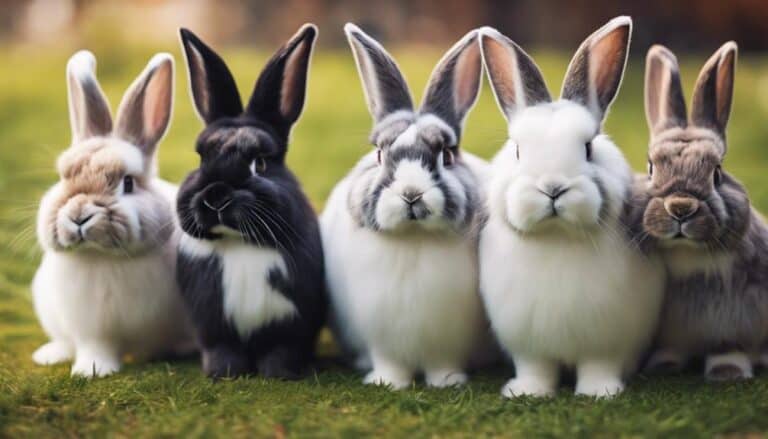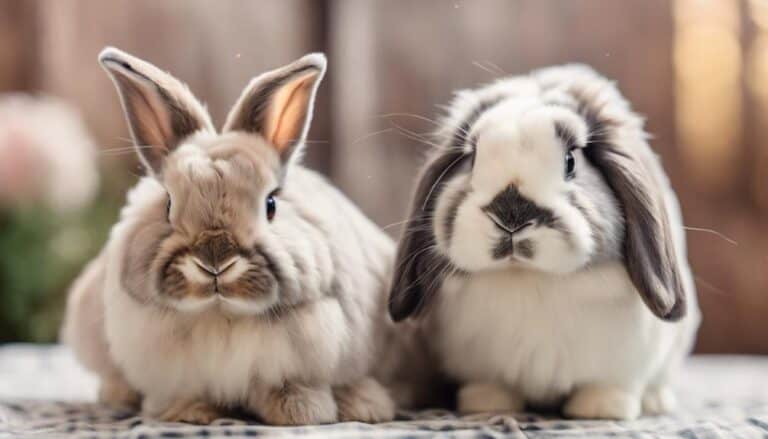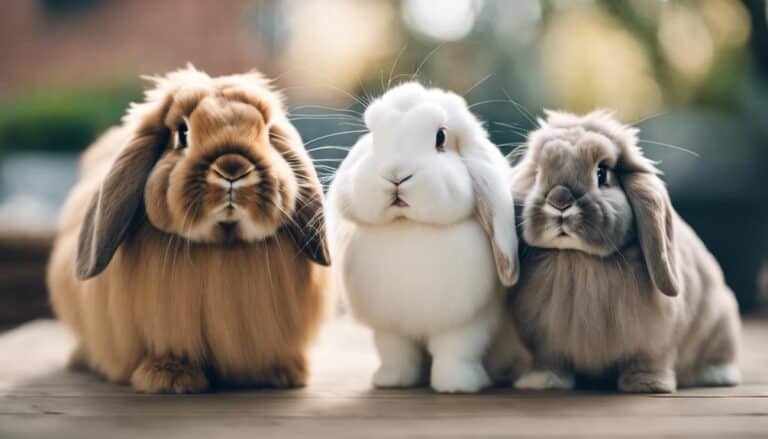Ever wondered why certain bunny breeds sport a diverse array of eye colors?
Well, the answer lies within the intricate world of genetics. Different genetic factors play a vital role in determining the eye color of bunnies, ranging from dominant and recessive genes to unique mutations.
These genetic intricacies not only make each bunny breed visually striking but also offer a fascinating glimpse into the marvels of nature.
Explore the enthralling domain of bunny eye colors and uncover the mesmerizing genetic tales behind their enthralling gaze.
Contents
Key Takeaways
- Bunny breeds exhibit diverse eye colors due to genetic factors like dominance, recessiveness, and mutations.
- Amber eyes in bunnies result from a yellow gene overriding the brown gene, common in wild rabbits.
- Blue eyes in bunnies stem from a recessive gene for eye color, adding charm and uniqueness.
- Pink eyes in bunny breeds arise from a genetic mutation diluting brown pigment to pink, creating rare and distinct features.
Common Bunny Eye Colors
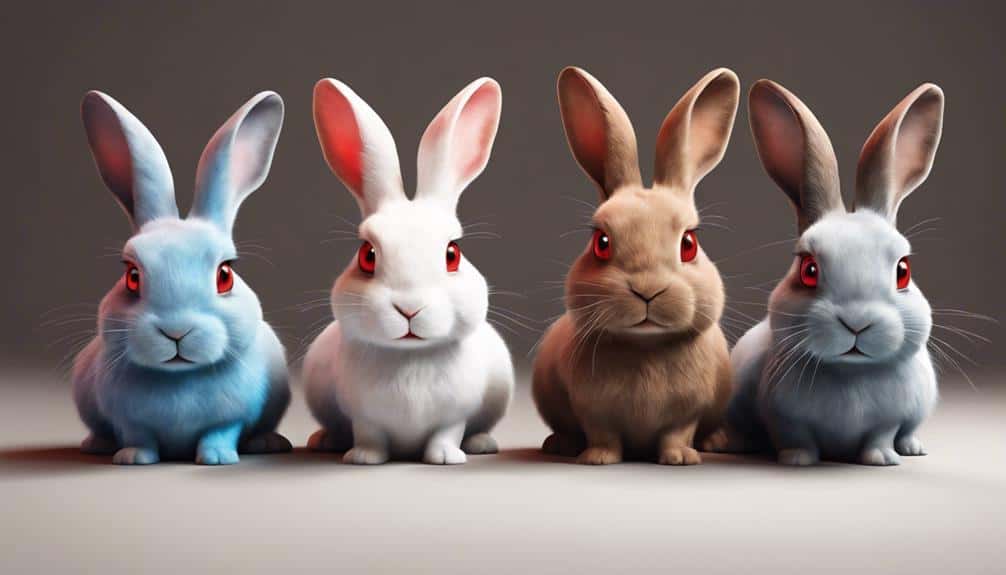
What're the common eye colors found in bunnies?
Rabbits exhibit a fascinating array of eye colors, with brown, amber, blue, blue/grey, and pink being the most prevalent. The most common eye color in rabbits is brown, attributed to a dominant gene in domestic breeds.
Contrary to this, amber eyes are rarer among domestic rabbits but are more frequently observed in wild rabbit populations. This coloration occurs when a yellow gene overrides the typical brown.
Blue eyes, on the other hand, are a recessive trait in rabbits, displaying various shades influenced by pigment interactions within the eye.
Lastly, pink eyes in rabbits are exceptionally rare and are the result of a genetic mutation that dilutes the brown pigment to a delicate pink.
Understanding the diversity of eye colors in rabbits adds to the beauty and intrigue of these adorable creatures, showcasing the intricacies of genetic inheritance and variation within the rabbit population.
Amber Eyes in Bunny Breeds
Amber eyes, a distinctive trait in bunny breeds, are more commonly observed in wild rabbits than in domestic varieties. This unique eye color is a result of a yellow gene overpowering the brown gene in certain bunny breeds, leading to the striking amber hue. In the wild, hares often showcase these alluring amber eyes, adding to their allure and beauty.
While domestic bunny breeds typically exhibit a range of eye colors, those with amber eyes stand out for their touch of wild elegance. The rarity of amber eyes in domestic bunny breeds makes them particularly unique, adding to their individuality and charm. Observing a domestic bunny with amber eyes can evoke a sense of connection to their wild counterparts, highlighting the diverse beauty found within bunny breeds. Whether in the wild or in domestic settings, amber eyes bring a touch of mystique and fascination to these beloved animals.
Blue Eyes in Bunny Breeds
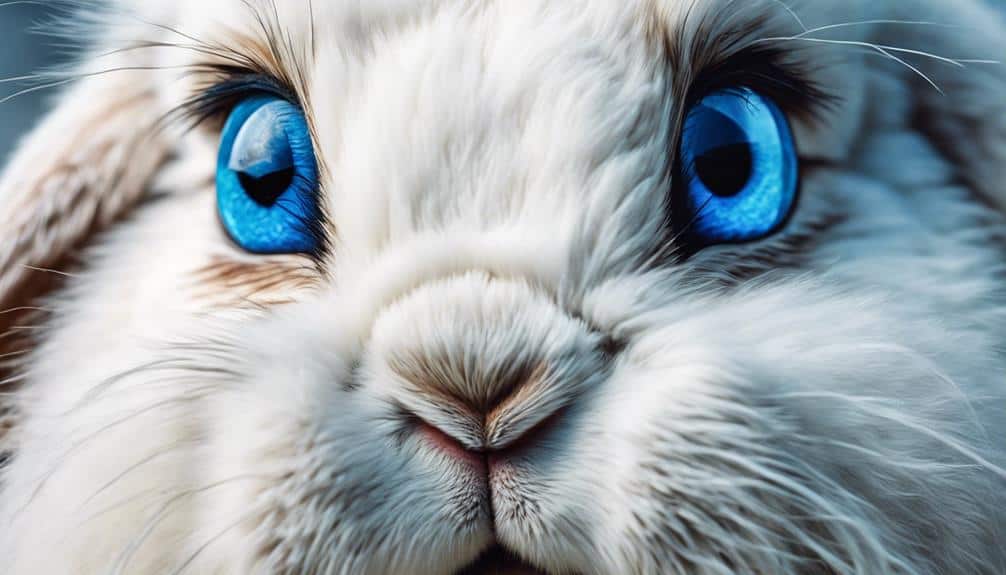
Blue eyes in bunny breeds are a result of a recessive gene for eye color, leading to a unique and striking feature that adds to their individuality and charm. When it comes to the genetics behind blue eyes in bunnies, it's fascinating to understand how pigment interactions play an important role in determining this distinct eye color.
The intensity of blue eyes can vary among bunny breeds, making each one special in its own way. Here are some key points to think about regarding blue eyes in bunny breeds:
- Blue eyes in bunny breeds are a result of a recessive gene for eye color.
- Specific pigment interactions contribute to the manifestation of blue eyes in certain bunny breeds.
- The varying intensity of blue eyes in bunny breeds adds to their unique and charming appearance.
Bunny Breeds With Pink Eyes
Pink-eyed bunnies, resulting from a genetic mutation that dilutes brown pigment to a pink hue, exhibit a rare and unique eye coloration that distinguishes them from other rabbit breeds. These pink eyes are a result of recessive gene copies that interfere with the production of brown pigment, leading to this distinct color.
Unlike albino red eyes, pink eyes in bunny breeds are incredibly rare. Pink-eyed bunnies may sometimes display hints of brown or blue in their eye coloration, adding to their unique appearance.
The occurrence of pink eyes in bunnies is a result of specific gene requirements and is considered a rare and outstanding trait within the diverse spectrum of bunny eye colors. This fascinating genetic mutation that dilutes the brown pigment to create pink eyes showcases the intricate and varied nature of eye colors in different bunny breeds.
Ruby Red Eyes in Bunny Breeds
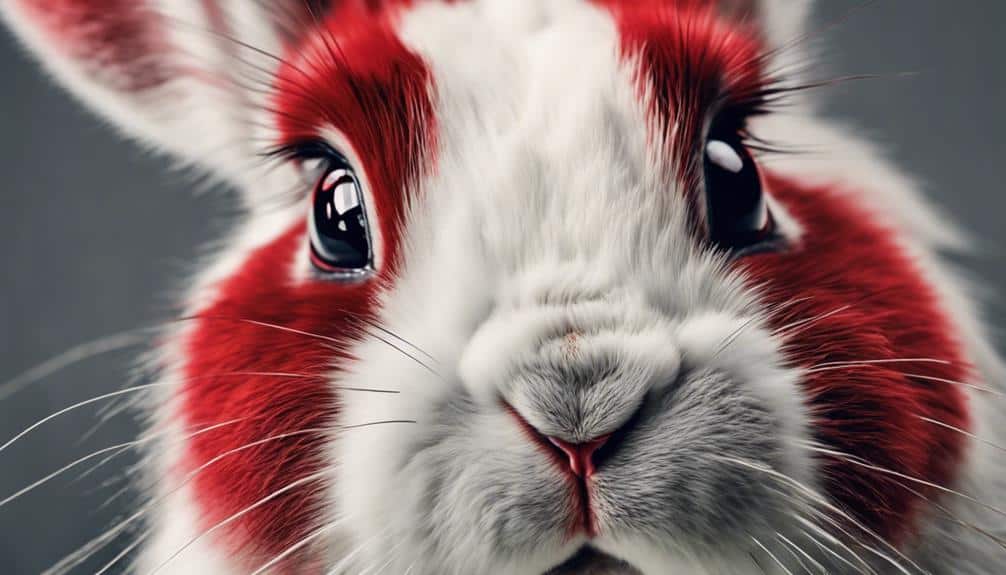
If you own a rabbit with ruby red eyes, you likely have a pet with albinism, a genetic condition that affects eye and coat color. This unique trait is rare in rabbits and can lead to red-eyed white bunnies.
Due to the lack of pigmentation, these red-eyed rabbits may have poorer eyesight and be more sensitive to light.
Genetic Factors in Eye Color
Genetic factors play an important role in determining the unique trait of ruby red eyes in bunny breeds, with albinism being the underlying genetic condition responsible for the distinct red coloration.
Here are some key points to take into account:
- Albinism affects the production of melanin in the eyes, resulting in the red coloration.
- The albino gene is necessary for bunny breeds to exhibit ruby red eyes.
- The rarity of ruby red eyes in bunny breeds often makes them stand out and be associated with specific breed standards.
This trait, while visually striking, can also lead to challenges such as poorer eyesight and increased sensitivity to light due to the lack of protective pigmentation.
Impact of Breeding
Breeding programs strategically focus on maintaining the albino gene to perpetuate the unique trait of ruby red eyes in bunny breeds. The albino rabbits exhibit red eyes due to a lack of pigmentation, a result of albinism overriding other eye colors. Specific breeds like the Florida White, Himalayan, and Californian have been selectively bred to showcase this distinctive characteristic.
Through careful genetic selection, breeders guarantee that the red-eyed white rabbits continue to pass down this rare and sought-after trait. By prioritizing the albino gene in their breeding programs, they aim to preserve the genetic makeup that gives these bunny breeds their striking ruby red eyes, making them stand out in the world of bunny breeding.
Environmental Influences
Maintaining the albino gene in bunny breeding programs guarantees the perpetuation of the unique trait of ruby red eyes in specific breeds like the Florida White, Himalayan, and Californian rabbits. Environmental influences play a critical role in preserving this distinctive feature.
- Genetic Mutation: The albinism gene leads to a lack of pigment in the eyes, resulting in the striking red color.
- Breeding Programs: Selective breeding is critical to the continuation of the gene responsible for ruby red eyes in bunny breeds.
- Specific Breeds: Ruby red eyes are rare and commonly found in breeds like the Florida White, Himalayan, and Californian rabbits, where breeding programs focus on maintaining this unique characteristic.
Marbled Eyes in Bunny Breeds
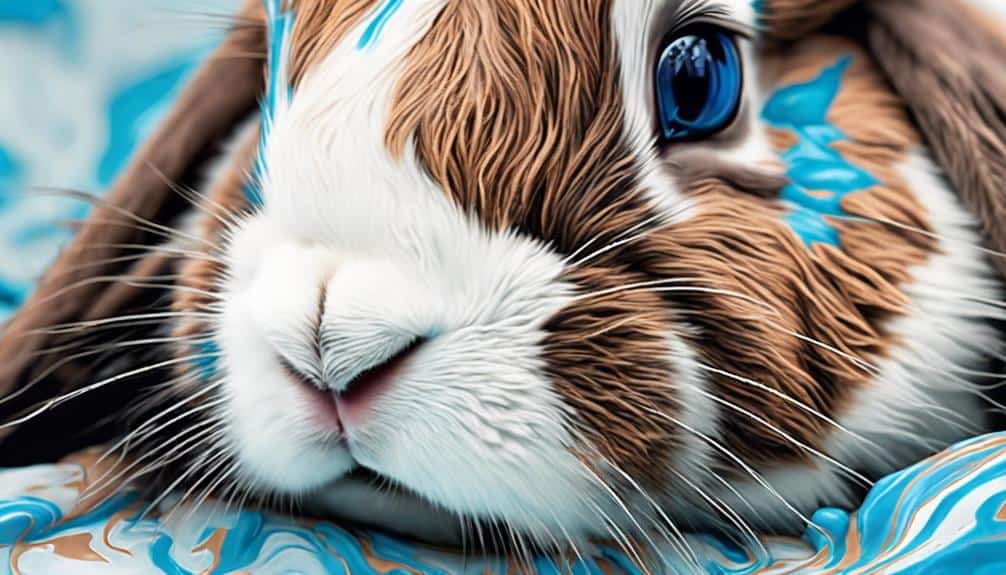
Marbled eyes in bunny breeds showcase intricate iris patterns featuring two or more colors, enhancing the individuality of these rabbits. This unique trait, resulting from sectoral heterochromia, where parts of the iris have different colors, is a rare occurrence that adds to the aesthetic appeal of the rabbits.
The gene combination responsible for marbled eyes contributes to their striking appearance, making these bunnies stand out among others. Breeders often value rabbits with marbled eyes for their rarity and enchanting look, as they bring a sense of individuality to the breed.
Observing these rabbits with their marbled eyes can be a fascinating experience, as each pattern is distinct and adds a touch of charm to the overall appearance. The beauty of marbled eyes in bunny breeds serves as a proof to the wonders of genetic diversity and the remarkable variations that can occur within a single species.
Frequently Asked Questions
Why Does My Rabbit Have 2 Different Colored Eyes?
Your rabbit has 2 different colored eyes due to genetic variations. It's a unique trait that can impact breeding choices and show eligibility. Make sure proper eye care and appreciate the striking appearance of this feature.
What Is the Genetic Color of Rabbits Eyes?
Rabbit eye pigmentation is determined by inherited traits. The genetics behind eye coloration involve iris variation due to genetic mutations. Specific genes influence eye development, leading to diverse color patterns such as brown, amber, blue, blue/grey, and pink.
Is Heterochromia Rare in Bunnies?
Heterochromia in bunnies is rare, with one eye being a distinct color due to a genetic mutation. This unique trait can impact breeding practices and breed standards. While not common, it can be a visually striking and inherited trait.
Why Does the White Rabbit Have Pink Eyes?
In white rabbits, pink eyes result from a genetic mutation diluting brown pigment to pink. This unique eye color is due to specific gene copies. Pink eyes are distinct from albino red eyes, contributing to their striking appearance.
What Causes Some Bunny Breeds to Have Different Eye Colors?
Some bunny breeds with unique eye colors have a genetic mutation that causes variations in eye pigment. This mutation can result in striking shades like blue or red. Factors like breeding and genetics also play a role in determining the eye colors of different bunny breeds.
Conclusion
You have explored the fascinating world of bunny eye colors and the genetic factors that influence them.
Did you know that approximately 10% of all bunny breeds exhibit rare ruby red eyes, showcasing unique genetic variations?
These distinctive eye colors not only add to the beauty of rabbits but also highlight the complexity of genetics in creating diverse and enthralling characteristics in different bunny breeds.

